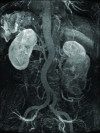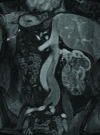A case of renal cell carcinoma in a patient with situs inversus: Operative considerations and a review of the literature
- PMID: 28503239
- PMCID: PMC5426946
- DOI: 10.5489/cuaj.4290
A case of renal cell carcinoma in a patient with situs inversus: Operative considerations and a review of the literature
Abstract
Situs inversus, an uncommon mirror-image reversal of the major visceral and thoracic organs, is seldom of medical significance. However, the recognition of their unique anatomy is extremely important for those requiring surgical intervention. There are very few reported cases of renal cell carcinoma (RCC) developing in people with situs inversus. To our knowledge, this is the first reported case in Canada. A review of the literature only identified nine published cases worldwide. Here, we review and summarize pertinent information, including patient age and sex, size and location of tumour, method of surgery, and pathology. Our case, a 65-year-old male, presented with left flank pain and gross hematuria. He was diagnosed with left renal cancer as well as tumour thrombus extending into the left renal veins and inferior vena cava (IVC), clinical T3aN0M0. An abdomen and pelvis computed tomography (CT) scan showed a left-to-right reversal of his organs, a mirror-image, and situs inversus was diagnosed. A left radical nephrectomy with left renal vein and IVC tumour thrombectomy through a left open midline incision was performed.
Conflict of interest statement
Competing interests: The authors report no competing personal or financial interests.
Figures




Similar articles
-
Hand-assisted laparoscopic radical nephrectomy for renal cell carcinoma in a patient with situs inversus totalis.Urol Case Rep. 2019 Nov 20;28:101076. doi: 10.1016/j.eucr.2019.101076. eCollection 2020 Jan. Urol Case Rep. 2019. PMID: 31788431 Free PMC article.
-
Transitional cell carcinoma with extension of the renal vein and IVC tumor thrombus: report of three cases and literature review.World J Surg Oncol. 2016 Dec 28;14(1):309. doi: 10.1186/s12957-016-1041-z. World J Surg Oncol. 2016. PMID: 28031042 Free PMC article. Review.
-
Laparoscopic radical nephrectomy for a right renal tumor with renal vein tumor thrombus in a patient with situs inversus totalis.Asian J Endosc Surg. 2019 Apr;12(2):185-188. doi: 10.1111/ases.12608. Epub 2018 May 23. Asian J Endosc Surg. 2019. PMID: 29791972
-
Robot-assisted Laparoscopic Inferior Vena Cava Thrombectomy: Different Sides Require Different Techniques.Eur Urol. 2016 Jun;69(6):1112-9. doi: 10.1016/j.eururo.2015.12.001. Epub 2015 Dec 17. Eur Urol. 2016. PMID: 26706105
-
[Renal pelvic cancer with tumor thrombus in the vena cava inferior: a case report].Hinyokika Kiyo. 2004 Dec;50(12):869-72. Hinyokika Kiyo. 2004. PMID: 15682860 Review. Japanese.
Cited by
-
Robotic-assisted pulmonary lobectomy with lung cancer in a patient with situs inversus totalis.J Cardiothorac Surg. 2022 Sep 1;17(1):221. doi: 10.1186/s13019-022-01983-8. J Cardiothorac Surg. 2022. PMID: 36050769 Free PMC article.
-
Robot-Assisted Radical Cystectomy with Intracorporeal Ileal Conduit in a Patient with Situs Inversus Totalis.J Endourol Case Rep. 2020 Sep 17;6(3):135-138. doi: 10.1089/cren.2019.0137. eCollection 2020. J Endourol Case Rep. 2020. PMID: 33102709 Free PMC article.
-
Robot-assisted partial nephrectomy for T1b renal cell carcinoma with complete situs inversus totalis with pre- and intraoperative three-dimensional virtual imaging.Urol Case Rep. 2023 May 1;49:102413. doi: 10.1016/j.eucr.2023.102413. eCollection 2023 Jul. Urol Case Rep. 2023. PMID: 37228258 Free PMC article.
-
Solitary adrenal metastasis from advanced gastric cancer invading duodenal bulb with situs inversus totalis: A case report.Medicine (Baltimore). 2019 Apr;98(15):e15244. doi: 10.1097/MD.0000000000015244. Medicine (Baltimore). 2019. PMID: 30985730 Free PMC article.
-
Hand-assisted laparoscopic radical nephrectomy for renal cell carcinoma in a patient with situs inversus totalis.Urol Case Rep. 2019 Nov 20;28:101076. doi: 10.1016/j.eucr.2019.101076. eCollection 2020 Jan. Urol Case Rep. 2019. PMID: 31788431 Free PMC article.
References
-
- Levin M. The embryonic origins of left-right asymmetry. Crit Rev Oral Biol Med. 2004;15:197–206. https://doi.org/10.1177/154411130401500403. - DOI - PubMed
-
- Treiger BF, Khazan R, Goldman SM, et al. Renal cell carcinoma with situs inversus totalis. Urology. 1993;41:455–7. https://doi.org/10.1016/0090-4295(93)90507-7. - DOI - PubMed
-
- Adler HL, Lerner SP. Renal cell carcinoma and situs inversus viscerum. J Urol. 1998;160:2141–2. https://doi.org/10.1016/S0022-5347(01)62262-6. - DOI - PubMed
-
- Hoffmann D, Gunselman J, Chewaproug D, et al. Living-related donor nephrectomy in a patient with complete situs inversus. J Exp Clin Med. 2010;2:305–6. https://doi.org/10.1016/j.jecm.2010.10.005. - DOI
-
- Patel RB, Gupta NR, Vasava NC, et al. Situs inversus totalis (SIT) with hepatocellular carcinoma (HCC): A rare case report and review of 12 other cases. Indian J Surg. 2013;75:424–9. https://doi.org/10.1007/s12262-012-0744-9. - DOI - PMC - PubMed
LinkOut - more resources
Full Text Sources
Other Literature Sources
